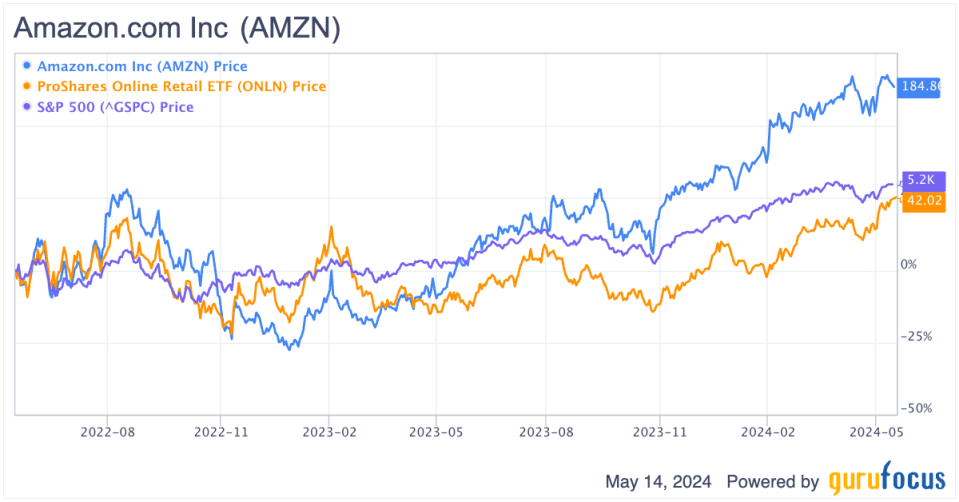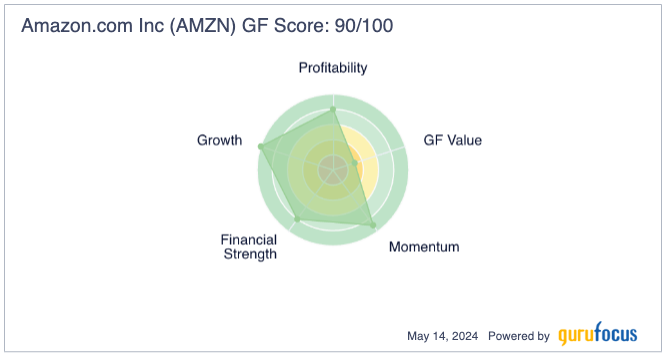Amazon Is Flying High, but Is It Now Overvalued?
Amazon.com Inc. (NASDAQ:AMZN) is mainly known for its online retail marketplace, which has been a go-to website for individuals to find great deals on things ranging from large appliances to clothing, electronics and toys. If a product exists, you can be sure it can be found on Amazon.
The stock has doubled in price since its lows at the start of 2023. Shares have significantly outperformed the S&P 500 and online retailer segment during this time.
AMZN Data by GuruFocus
Amazon's traditional operating segments
When people think of Amazon, they think of their e-commerce site, Amazon Prime and Prime Video. These segments account for almost 85% of the e-commerce giant's revenue and are a very important part of its business. This is what I am including in Amazon's traditional operating segments (essentially, everything but Amazon Web Services):
Online stores - revenue generated from selling items on Amazon.com.
Third-party seller services - from fees from other businesses that sell on Amazon, which includes sales commissions, fees for inventory storage and shipping fees.
Advertising services - revenue generated from sponsored ads on Amazon.com and commercials on Prime Video.
Subscription services - revenue from customer subscriptions to Amazon Prime.
Physical stores - revenue from physical store locations.
Other - includes everything else from Amazon's health care services to fees from its credit card.
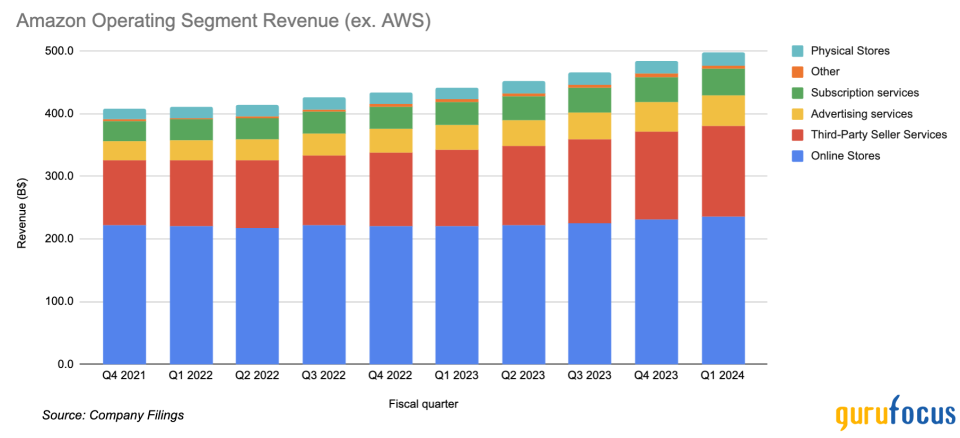
The growth in these segments is high, but has been slowing recently. The main reason is increased competition. Amazon was the major early-adopter in e-commerce and subscription-based shipping as well as a lesser early-adopter in online video streaming. However, competitors have caught up and have been slowly chipping away at Amazon's market share.
What is the future of this segment?
Amazon has made some changes to better position itself in a crowded market. The biggest change is including commercials in its Prime Video offerings, which started this past January. This worried investors, but it has paid off. In the first quarter, subscription revenue rose over 20% compared to the prior year, showing consumers were fine with the change and kept their Amazon Prime subscriptions.
Advertising revenue also saw a benefit from that change, growing over 24% in the first quarter compared to the prior year.
The company also recently announced these commercials will soon allow Prime Video watchers to purchase advertised products during the break. I think this is a great and innovative idea from Amazon. Competing video streaming platforms are unable to replicate this functionality since none of them have their own e-commerce store. It is also important to note that Amazon has a lot of data about its subscribers and can target their commercials more effectively than competitors.
Amazon in the cloud
Amazon Web Services, or AWS, is Amazon's cloud service. It generates revenue through cloud computing, storage and database services for various organizations.
The company has separated out its AWS revenue since 2013 and it has grown like a rocket, gaining almost 30 times in the last decade and accounting for 16% of sales.
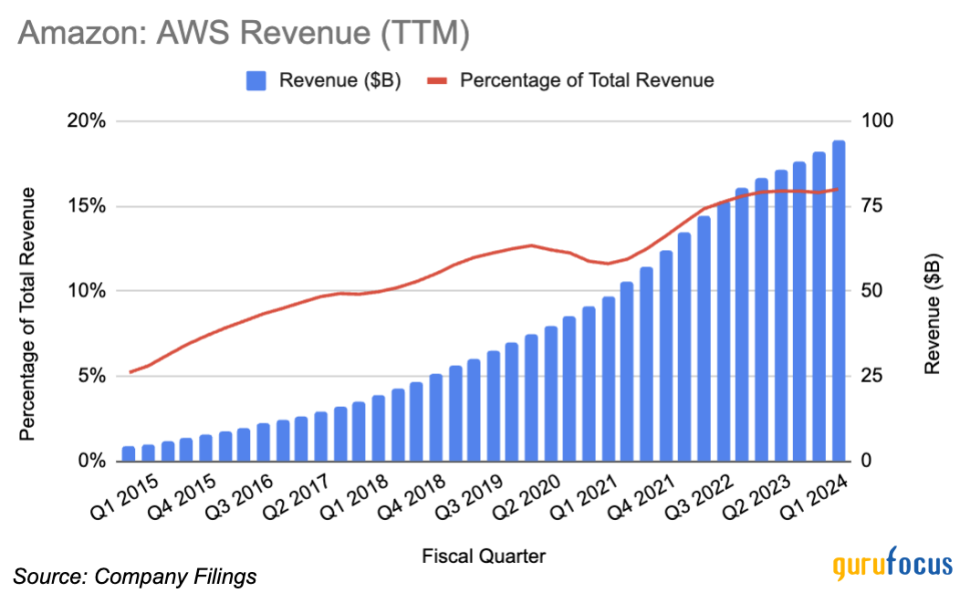
AWS is the leading provider within the cloud computing industry, accounting for almost a third of the market share.
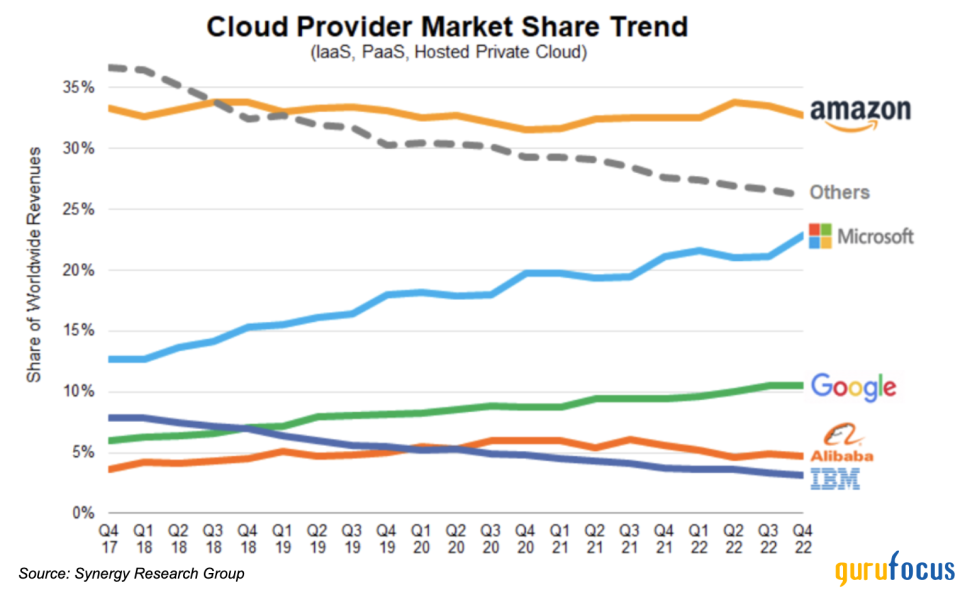
The future of AWS
The cloud services industry is expected to grow significantly over the next decade. Revenue is expected to be 20% higher in 2024 and triple current values by 2032.
Even with rapid industry growth and increased competition, Amazon has been able to maintain market leadership and its 30% to 35% market share. There is no reason to believe that is going to change.
During the first-quarter 2024 conference call, Chief Financial Officer Brian Olsavksy mentioned the importance of AWS and the investment Amazon is making to ensure its success:
"As I mentioned, we're seeing strong AWS demand in both generative AI and our non-generative AI workloads, with customers signing up for longer deals, making bigger commitments. Still relatively early days in generative AI and more broadly, the cloud space, and we see sizable opportunity for growth. We anticipate our overall capital expenditures to meaningfully increase year-over-year in 2024, primarily driven by higher infrastructure CapEx to support growth in AWS, including generative AI."
Valuation for Amazon
Analysts are forecasting 2024 annual revenue for Amazon just below $640 billion.
The company's enterprise value-sales ratio hovers around 3 historically. Morningstar analysts value Amazon using 3 times EV/sales, which I agree with. This leads to a fair value of $179.61 per share, which is currently just under 4% overvalued based on median revenue analyst estimates.

I think Amazon is going to outperform analyst expectations and I am forecasting revenue to be above $643 billion. At 3 times EV/sales, this results in a price target of $181. Here is why I think Amazon is going to exceed analyst expectations:
Traditional segment revenue is going to be higher than analysts expect. Advertising, online stores and third-party seller services are going to drive this outperformance through targeted commercials steering consumers to purchase more products from Amazon.
AWS revenue is going to maintain its position as the market leader in the cloud industry and continue its 30% to 35% market share. This will be accomplished because Amazon is heavily investing in this growing space.
Amazon revenue forecasted by analysts has surprisingly fallen over the last 90 days. This is despite the company beating expectations in the first quarter.
Amazon is currently trading at $186.57, which is slightly higher than my valuation of $181. Even though I think that is slightly overvalued, I like the stock as an investment.
The GF Score agrees at 90 out of 100:
An option to buy-in
The most straightforward way to buy into Amazon is to simply purchase shares. However, investors have different ways to get exposure to Amazon and one alternative I really like is selling put options to purchase the stock.
Amazon is currently slightly overvalued and put options can allow investors to collect some premium while potentially purchasing the stock at a specified price. As an example, we can look at options expiring at the end of May.

I like the stock around $181 and analysts like it just under $180, so let's focus on put options with a strike price at $180.
Put options at $180 for May 31 expiration are selling at around $1.25. Options are in contracts of 100, so if an investor sold this put option, they would receive $125 to purchase 100 shares of Amazon on that day at $180. If shares of Amazon are trading above $180, the option would expire worthless and the investor would keep the $125 premium. If the price is below $180 on that date, the investor would purchase 100 shares of Amazon at $180 (which requires $18,000 in available capital).
If an investor does not have the available cash to buy 100 shares of Amazon, or if they do not want that much exposure, then purchasing the shares outright is definitely the better choice. However, getting paid ($125) to buy a stock we like at a price we want ($180) is a great way to add income to your portfolio.
This article first appeared on GuruFocus.

 Yahoo Finance
Yahoo Finance 